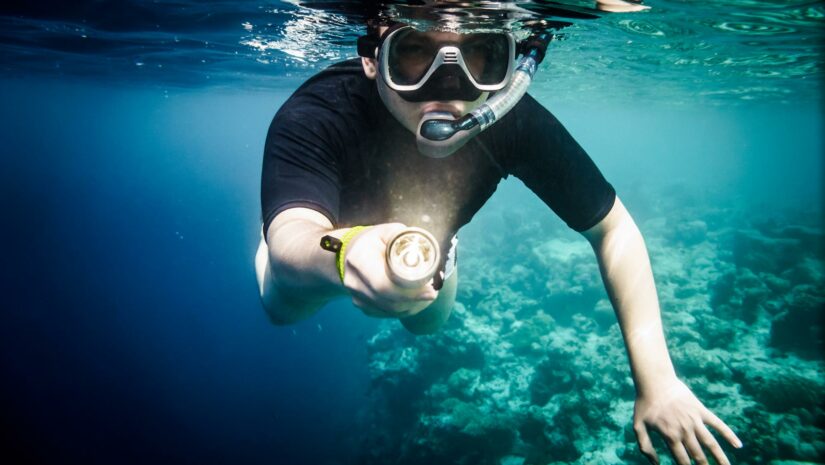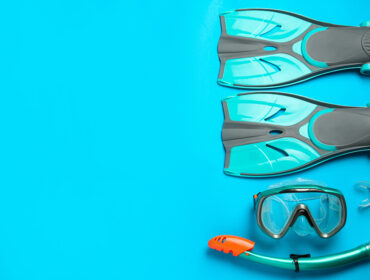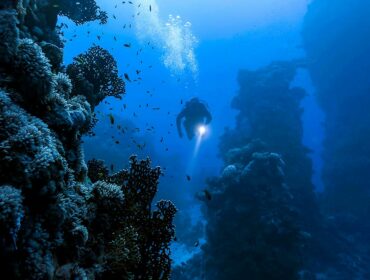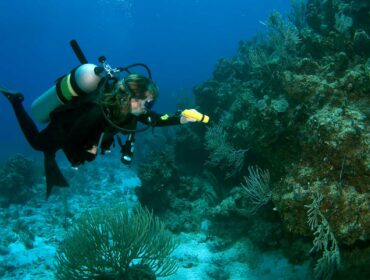The most important pieces of scuba diving equipment are those that help ensure your safety underwater, which is essentially all of them. However, one of the most crucial items for both your safety and enjoyment is dive lights (flashlights), which should always be on hand, whether you’re diving during the day or at night.
Beginner divers typically dive to a depth of 50 feet and can reach depths of almost 130 feet once they gain more experience. But at just 30 feet, everything loses its color. It will simply show up in shades of blue and gray, and that’s not exactly ideal if you’re in it for the unique visual experience of seeing underwater scenery up close.
A decent scuba light will be your best friend during your dives, as it will not only help reveal the beautiful colors of underwater life but also guide your path to safety in darker, deeper waters. If you’re looking to purchase one for your next scuba or freediving excursion, we’ve compiled a quick guide to help you navigate the different types of scuba diving lights available on the market.
But first, here are a few things you’ll need to consider:
What activities will you be engaging in? Do you often dive during the day or at night?
As there are different types of scuba lights, you’ll need to consider what activities you plan to engage in so you can choose the best light source for your needs. If you’re planning on going spearfishing, for instance, then you’re better off with a dive light that can be mounted to your weapon or to a part of your body, leaving both hands free to operate your weapon and other tools; or if your dives consist mainly of exploring underwater caves and mysterious shipwrecks, you may find a large primary light more useful.
A dive light’s beam angle is another thing you should consider when choosing the right type of underwater light source. A wider beam angle is what you’ll need for night diving, as it provides maximum visibility. In comparison, a narrower beam angle will be more useful for illuminating specific spots, such as when you need to see into an underwater crevice or underneath some rocks. It’s also the better option for murky, low-visibility waters.
How deep will you be diving? What is the usual duration of your dives?
Obviously, the longer your dive light’s power duration is, the more reliable it will be during deep dives. This depends on the type of material used to build a dive light: Xenon (incandescent), LED (light-emitting diode), and HID (high-intensity discharge).
Xenon is usually less expensive, less powerful, and has a shorter battery life. The primary reason many serious divers opt for Xenon dive lights is that they produce warmer colors, which can enhance the appearance of marine life in photos and videos.
LED and HID scuba diving lights offer more powerful light for longer durations. LEDs, however, have become the most popular type, as they are more energy-efficient, robust, and durable compared to HID dive lights.
The deeper you dive, the darker it gets, which is why it’s crucial to choose a powerful light source. If you tend to do longer dives, make sure to choose a dive light that offers longer battery life.
What is your budget?
Dive lights become more expensive when they come with more powerful bulbs and longer operation times. But given the fact that dive lights help ensure your safety underwater, they become very worthy investments in the long run. This is particularly true for LED lights, considering they last longer than HIDs and provide more power than Xenons.
Then again, even affordable lights can add to the bill when multiple pieces and a rig are needed to put them all together, which is often the case for photography and videography. Using cheap disposable batteries also tends to result in higher costs in the long run than investing in rechargeable batteries, so keep that in mind as well.
The key is to understand when you can and cannot compromise, so you don’t end up overspending on gear that you don’t need or on low-quality equipment that will need replacing sooner rather than later.
Types of Dive Lights
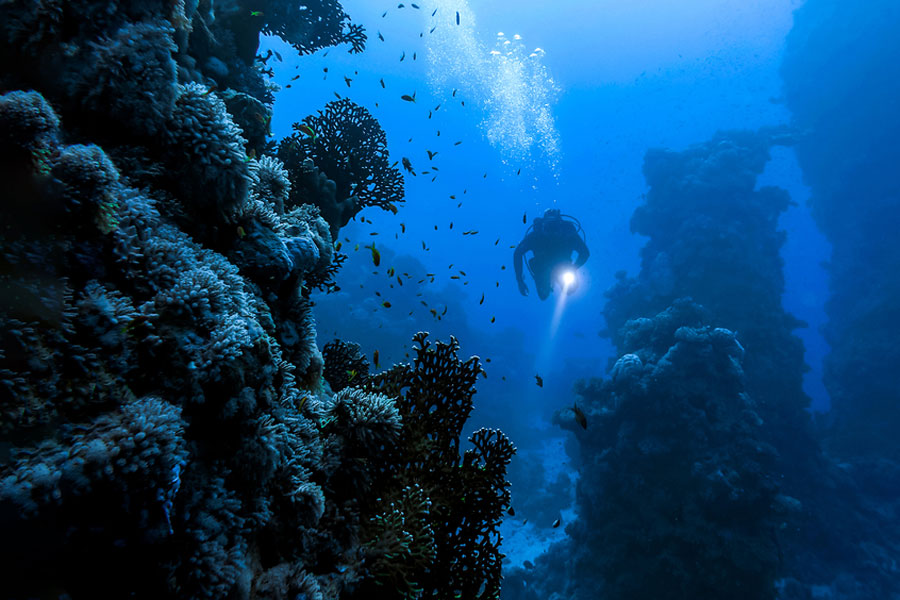
To determine which dive light will best suit your needs, it’s essential to understand its characteristics as well as the types of environments and diving situations it’s well-suited for. Here are the six distinct types of dive lights and their functions:
Primary Dive Lights

Primary dive lights are handheld light sources. They are typically large and bright, designed for use during both daytime and nighttime dives in murky or deep waters. Armed with either a pistol grip or lantern grip, divers normally find this type of dive light to be more comfortable to use than stick lights. The coverage is quite wide, and its power is primarily focused on the center beam, allowing it to penetrate through the most turbid waters without requiring any additional light sources.
This powerful dive light can be quite expensive, mainly because it is very durable and can last up to 10 years. It can use either rechargeable or disposable batteries and offers three different bulb choices: inexpensive halogen bulbs that give off that traditional warm lighting; pricey HID bulbs that produce up to five times the power of halogen bulbs; and the long-lasting LED lights that offer more light power than older halogens, but at an affordable price.
When you’ll need it: Night and deep-water dives in low-visibility waters
Recommended products:
- Underwater Kinetics C8 eLED (L2) Rechargeable Dive Light
- Light & Motion Sola Nightsea 3000 Lumens Dive Light
- Underwater Kinetics Light Cannon L1 eLED Dive Light
Secondary Dive Lights

Secondary dive lights are smaller handheld light sources that can be used for extra illumination during daytime dives. However, its main purpose is to serve as a backup for your primary dive light in case the latter stops working or runs out of battery. These types of lights are pretty compact and can be inserted right into the pockets of your buoyancy compensator.
Keep in mind that since they are smaller, they do offer a much narrower beam than other dive lights.
When you’ll need it: Shallow daytime dives or when your primary light malfunctions
Recommended Products:
Mounted Dive Lights

This type of dive light is for divers who need both their hands free when spearfishing, treasure hunting, or exploring underwater caves and wrecks. It’s usually mounted to the wrist or on top of the hand, sometimes in addition to a head-mounted one similar to what hikers and campers use.
Mounted underwater light sources that use disposable batteries are more ideal than those with rechargeable ones, as they last longer and can be used as soon as needed (as long as a fresh pack of batteries is available, of course). However, this is still a matter of personal preference. Using disposable batteries is not exactly environmentally friendly, and it may even cost you more money in the long run.
These types of lights tend to be very small and compact, so make sure to choose a good one (don’t settle for the cheapest option) that is capable of producing an intense beam of light despite its size.
When you’ll need it: Hands-free diving, spearfishing, treasure-hunting, underwater cave explorations
Recommended Products:
Canister Dive Lights

Also known as canister lights, this type of rechargeable dive light is commonly used by technical divers and deep-water divers who explore wrecks and caves. It features a separate canister that houses the battery pack and is connected to the light bulb via a thick, long power wire. This allows the battery to be much larger and contain more power, helping it give off a brighter and usually wider beam of light compared to your primary light. And since the bulb is separate from the apparatus, you can easily attach it to a certain part of your body, such as your waist or wrist.
When you’ll need it: Deep-water explorations that need a much brighter light with wider coverage
Recommended Products:
Photography/Videography Dive Lights

Photography dive lights are essentially underwater light sources that emit a flash of light simultaneously with each image capture. Meanwhile, video dive lights offer a more consistent, wide, and even flood of light to properly expose an entire scene, as opposed to a primary light that has a heavy “hotspot” in the middle. Dive lights used for photography and videography are typically adjustable, allowing you to properly expose your shots.
When you’ll need it: Underwater photography and videography
Recommended Products:
- SeaLife Sea Dragon Duo X2 Underwater Flash Set SL988
- SeaLife Sea Dragon 2500F UW Photo-Video-Dive Light Head
Marker Dive Lights

Marker lights make you visible to your dive buddies, especially in low-visibility waters and when your primary or secondary light is pointed away from them. In this case, the lumens rating doesn’t matter as much, so these can be as simple and cheap as glow sticks. However, glow sticks are not environmentally friendly due to their single-use nature and should be avoided.
For longer burn times, non-disposable ones like flares and LED strobes are highly recommended. They come in many different colors and are usually attached to your tank valve or taped securely to your snorkel.

